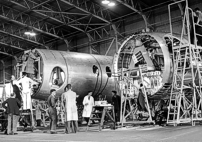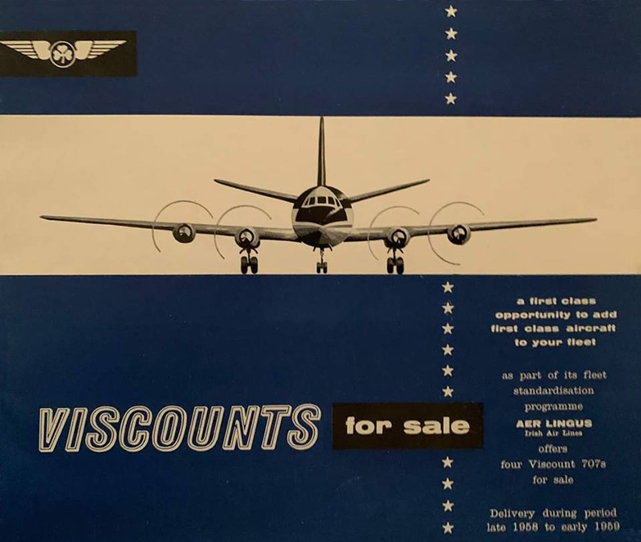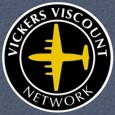
March 1954 to December 1959
Aer Lingus - Irish International Airlines
EI-AFW - c/n 31 - a V.707 series Viscount
Ireland registered
February 1951
Vickers-Armstrongs (Aircraft) Ltd announced that Aer Lingus were negotiating the purchase of four Type 700 series aircraft.
9 November 1951
An order was placed by Aer Lingus for four Type 707 aircraft which would have a two crew cockpit and a 48 seat cabin.
The order for these four aircraft was worth £800,000.
At that time British European Airways Corporation (BEA) held a 30% stake in the airline.
Production Aircraft No. 28 - the 28th production Type 700 series Viscount built,
was the 2nd Viscount fuselage assembled at Hurn, Bournemouth, Hampshire, England,
and the 4th Viscount assembled at Hurn, Bournemouth, Hampshire, England.
Production Order No. F02/707. Sales Order No. F02/86A. Stock Order No. F10/21B.

Fuselage assembly at Hurn, Bournemouth, Hampshire, England
26 August 1953
Fuselage assembly commenced at Hurn Airport, Bournemouth, Hampshire, England.
8 November 1953
Fuselage to Erecting Shop 'E' at Hurn Airport, Bournemouth, Hampshire, England.
6 February 1954
Engine ground running commenced.
16 February 1954
First flight from Hurn Airport, Bournemouth, Hampshire, England.
7 March 1954
Departed at 10:30 local time on delivery to Aer Lingus named as 'St Brighid' / 'St Brigid' together with Viscount EI-AFV (C/N 30) as their first Viscounts.
The flight to Dublin was flown by Captain W Martin.
It was fitted with Rolls-Royce Dart Mark 506 engines with serial numbers 1170 and 1171 on the port side, and 1172 and 1173 on the starboard side.
2 April 1954
Departed from Dublin on a demonstration flight carrying the Sinn Féin President of Ireland Seán Tomás Ó Ceallaigh (O'Kelly) accompanied by his wife and a group of guests.
The flight lasted for 3 hours 45 minutes and covered about 750 miles over Ireland, mainly at a low level to provide a scenic view through those large windows.
The President took over the controls for a portion of the flight.
The flight was flown by Captains R N White, O McAlinden and J J Gallagher with Anna Greevy, B O'Connor and P Keane attending the cabin serving afternoon tea.
14 December 1954
During a flight from Collinstown Airport, Dublin, Ireland to Schiphol Airport, Amsterdam, Netherlands a near-miss was reported with a formation of Royal Netherlands Air Force Hawker Hunters. They were observed by the Viscount flight crew to be flying in and out of clouds and then dived down towards the Viscount before veering away.
1955
The cabin seating capacity was increased from 48 to 53.
18 March 1955
Temporarily withdrawn from service after the crash of BEA Type 701 G-ALWE (C/N 4) and replaced by two Douglas DC-3 aircraft on their routes.
22 March 1955
The Type 707 fleet returned to service after the completion of flap modification work.

Aer Lingus 'green top' livery
1955/1956
Painted in the Aer Lingus 'green top' livery that had a Winchester green cabin roof and an English green cockpit roof. The rudder was all white.

Aer Lingus
'green/white top' livery
May 1957
Ferried to Vickers-Armstrongs at Hurn Airport, Bournemouth, Hampshire, England for flap modifications. At this time the cockpit roof was painted white.

Aer Lingus
'green/white top Viscount' livery
circa 1957
The word 'Viscount' was added to the cabin roof.
24 September 1957
During the takeoff run from runway 08 at Collinstown Airport, Dublin, Ireland on flight EI 158 to London at 13:50 local time the No.3 Rolls-Royce Dart engine failed.
The Captain aborted the takeoff after 2,400 feet of runway had been used and overran the end of the wet runway resulting in the collapse of the nose undercarriage leg.
The aircraft then collided with runway 24 approach lights before ending up with the nose buried in the airport boundary fence. The No.3 and No.4 propellers became detached during this phase of the accident. All four Rolls-Royce Dart engines suffered from shockload damage which required an extensive repair shop visit.
Of the 54 passengers and 4 crew on board only one passenger was slightly injured by scalding from a beverage flask.
The service was operated by Captain Richard N White, First Officer Tom Fenning with Miss A McCarthy and Miss A McKenna in the cabin.
The passengers later continued their journey to London on board two Douglas DC-3, departing at 17:20 and 17:39 local time.
The cause of the loss of the No.3 Rolls-Royce Dart engine was due to the failure of the engine's High Pressure Fuel Pump.
Repaired and returned to service.
February 1958
Ferried to Teversham Airport, Cambridge, England for wing spar replacement work by Mashall's in order to extend the cycle fatigue life.
circa April 1958
Returned to service.
April 1958
Renamed as 'St Iarflaith' ('St Jarlath').
Later renamed as 'St Malachy'.
April 1959
Withdrawn from service at Collinstown Airport, Dublin, Ireland on the North Apron.
circa October 1959
Aer Lingus considered converting this aircraft and EI-AFV (C/N 30) and EI-AGI (C/N 34) to carry freight to replace their Douglas DC-3 freight fleet, but nothing came of it.

Artwork by Willem M van Velzen
circa November 1959
Ferried from Teversham Airport, Cambridge, England.
1 December 1959
Purchased by Sea Products Company as part exchange for Viscount VR-BAY (C/N 312). The deal also included Viscount EI-AFY (C/N 32).
 FURTHER READING: Books about Aer Lingus FURTHER READING: Books about Aer Lingus
|



